 It is common practice in the private sector to use big data to improve efficiency, strengthen product quality and better target services to customers. Can data also be used to improve the quality of public education, specifically Career Technical Education (CTE)?
It is common practice in the private sector to use big data to improve efficiency, strengthen product quality and better target services to customers. Can data also be used to improve the quality of public education, specifically Career Technical Education (CTE)?
The Strengthening Career and Technical Education for the 21st Century Act (Perkins V) gives states the opportunity to use data more strategically to improve quality and equity in CTE. While states have been collecting data for years on student performance in CTE programs, Perkins V pushes them to make more informed decisions about program approval and alignment, equity and access, and program improvement. In particular, states can drive program improvement through the new secondary CTE program quality indicator, a state-selected measure that will be included in each state’s accountability system starting in the 2020-21 program year.
To help states select and define a robust measure of secondary CTE program quality, Advance CTE – in partnership with the Data Quality Campaign; the Workforce Data Quality Campaign, a project of the National Skills Coalition; Education Strategy Group; and the Council of Chief State School Officers – developed a series of short briefs highlighting each of the three indicator options:
- The percentage of CTE concentrators graduating from high school having attained a recognized postsecondary credential.
- The percentage of CTE concentrators graduating from high school having attained postsecondary credits in the relevant CTE program or program of study earned through a dual or concurrent enrollment program or another credit transfer agreement.
- The percentage of CTE concentrators graduating from high school having participated in work-based learning.
Each brief examines the pros and cons of each indicator, describes different state approaches, and offers meaningful considerations for implementation. The reports also draw on survey data from one of Advance CTE’s latest report, The State of Career Technical Education: Improving Data Quality and Effectiveness to describe common approaches to collecting and validating program quality data.
Choosing a secondary CTE program quality indicator is a decision state leaders should not take lightly. This choice will send a clear signal to the field about state priorities for CTE and create an incentive structure that will be in place for years to come. To make an informed and thoughtful decision, state leaders should consider:
- What is the statewide vision for CTE and career readiness?
- What do stakeholders identify as priorities?
- Which experiences are equitably available to learners across the state?
- Is there any evidence to demonstrate which experiences are more highly correlated with positive post-program outcomes?
- What information is currently available at the state level?
- Are the data reliable, accurate and well defined?
- How can the program quality indicator align with other metrics the state is collecting?
The Measuring Secondary CTE Program Quality briefs are available in the Learning that Works Resource Center at this link. Advance CTE is also available to provide input and expertise to states as they select and define their Perkins V accountability measures.
Austin Estes, Senior Policy Associate


 One of the most significant and exciting changes introduced in the Strengthening Career and Technical Education for the 21st Century Act (Perkins V) is the new comprehensive local needs assessment (CLNA). The purpose of the CLNA is to support data-driven decisionmaking and more closely align planning, spending and accountability activities under Perkins V. The results of the local needs assessment must form the foundation of the local application and drive local spending decisions.
One of the most significant and exciting changes introduced in the Strengthening Career and Technical Education for the 21st Century Act (Perkins V) is the new comprehensive local needs assessment (CLNA). The purpose of the CLNA is to support data-driven decisionmaking and more closely align planning, spending and accountability activities under Perkins V. The results of the local needs assessment must form the foundation of the local application and drive local spending decisions.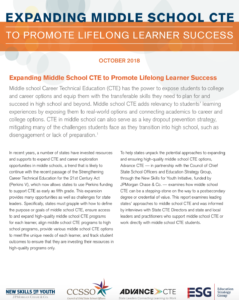 REPORT:
REPORT: 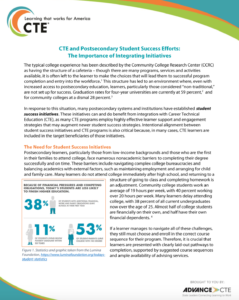 FACT SHEET:
FACT SHEET: 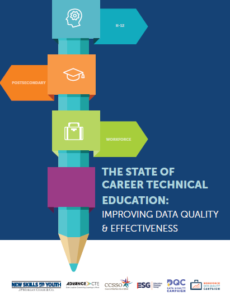 How many girls of color earned an industry-recognized credential in Information Technology last year? What types of work-based learning experiences lead to the best wage outcomes for learners from low-income families? How many graduates from Career Technical Education (CTE) programs in advanced manufacturing go on to work in their field of study?
How many girls of color earned an industry-recognized credential in Information Technology last year? What types of work-based learning experiences lead to the best wage outcomes for learners from low-income families? How many graduates from Career Technical Education (CTE) programs in advanced manufacturing go on to work in their field of study? Ensuring learners are prepared with the skills and experiences they need for high-wage, high-skill employment in in-demand occupations is a shared responsibility among secondary education, postsecondary education and the workforce sector. Yet too many states continue to use disparate data systems for collecting, validating and accessing learner-level data. Using disparate systems not only increases the data collection burden for local leaders but also threatens the quality of the data and the ability of state leaders to use their data effectively.
Ensuring learners are prepared with the skills and experiences they need for high-wage, high-skill employment in in-demand occupations is a shared responsibility among secondary education, postsecondary education and the workforce sector. Yet too many states continue to use disparate data systems for collecting, validating and accessing learner-level data. Using disparate systems not only increases the data collection burden for local leaders but also threatens the quality of the data and the ability of state leaders to use their data effectively. The Met, a work-based learning focused technical center in Providence, Rhode Island, serves about 800 students across the state. It is also one of eight recipients of
The Met, a work-based learning focused technical center in Providence, Rhode Island, serves about 800 students across the state. It is also one of eight recipients of 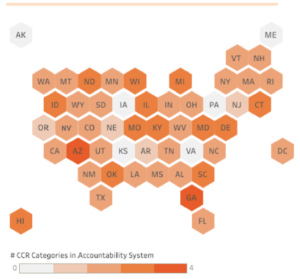 In a strong signal of support for Career Technical Education (CTE) and career readiness in high school, 40 states are now measuring career readiness in their state or federal high school accountability systems. Fewer than half as many – 17 – were measuring career readiness just five years ago.
In a strong signal of support for Career Technical Education (CTE) and career readiness in high school, 40 states are now measuring career readiness in their state or federal high school accountability systems. Fewer than half as many – 17 – were measuring career readiness just five years ago.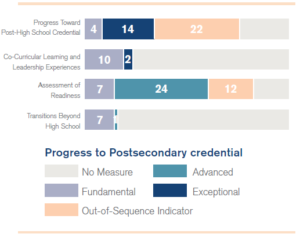 Another commonly used measure is Progress Toward Post-High School Credential. Seventeen states and the District of Columbia include measures aligned with the Destination Known recommendations, and another 22 states include out of sequence indicators. A number of states include either pathway completion or dual enrollment coursework in their accountability plans without requiring that experience to be accompanied by the completion of a state-defined college- and career-ready course of study, which is the Fundamental measurement in this category.
Another commonly used measure is Progress Toward Post-High School Credential. Seventeen states and the District of Columbia include measures aligned with the Destination Known recommendations, and another 22 states include out of sequence indicators. A number of states include either pathway completion or dual enrollment coursework in their accountability plans without requiring that experience to be accompanied by the completion of a state-defined college- and career-ready course of study, which is the Fundamental measurement in this category.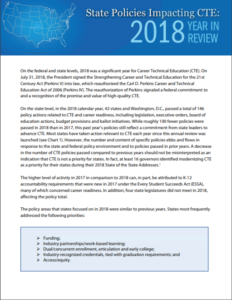 2018 was a significant year for Career Technical Education (CTE) at the federal and state levels. On July 31, 2018, the President signed the Strengthening Career and Technical Education for the 21st Century Act (Perkins V) into law, which reauthorized the Carl D. Perkins Career and Technical Education Act of 2006 (Perkins IV). The reauthorization of Perkins signaled a federal commitment to and a recognition of the promise and value of high-quality CTE. Additionally, at the state level 42 states and Washington, D.C., passed a total of 146 policy actions related to CTE and career readiness, reflecting a commitment from state leaders to advance CTE.
2018 was a significant year for Career Technical Education (CTE) at the federal and state levels. On July 31, 2018, the President signed the Strengthening Career and Technical Education for the 21st Century Act (Perkins V) into law, which reauthorized the Carl D. Perkins Career and Technical Education Act of 2006 (Perkins IV). The reauthorization of Perkins signaled a federal commitment to and a recognition of the promise and value of high-quality CTE. Additionally, at the state level 42 states and Washington, D.C., passed a total of 146 policy actions related to CTE and career readiness, reflecting a commitment from state leaders to advance CTE.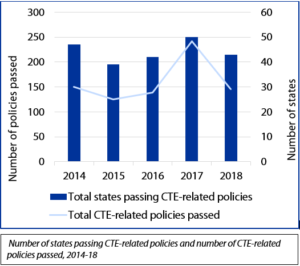 While roughly one hundred fewer policies were passed in 2018 than in 2017, this past year’s policies still reflect a commitment from state leaders to advance CTE. A decrease in the number of CTE policies passed compared to previous years should not be misinterpreted as an indication that CTE is not a priority for states. In fact,
While roughly one hundred fewer policies were passed in 2018 than in 2017, this past year’s policies still reflect a commitment from state leaders to advance CTE. A decrease in the number of CTE policies passed compared to previous years should not be misinterpreted as an indication that CTE is not a priority for states. In fact,  Throughout history, and continuing today, learners of color, low-income learners, female learners and learners with disabilities have been historically tracked into terminal vocational programs leading to jobs with uncertain promise of economic growth and prosperity.
Throughout history, and continuing today, learners of color, low-income learners, female learners and learners with disabilities have been historically tracked into terminal vocational programs leading to jobs with uncertain promise of economic growth and prosperity. Middle school Career Technical Education (CTE) has the power to expose students to college and career options and equip them with the transferable skills they need to plan for and succeed in high school and beyond. In recent years, a number of states have invested resources and supports to expand CTE and career exploration opportunities in middle schools, a trend that is likely to continue with the recent passage of the Strengthening Career Technical Education for the 21st Century Act (Perkins V), which now allows states to use Perkins funding to support CTE as early as the fifth grade.
Middle school Career Technical Education (CTE) has the power to expose students to college and career options and equip them with the transferable skills they need to plan for and succeed in high school and beyond. In recent years, a number of states have invested resources and supports to expand CTE and career exploration opportunities in middle schools, a trend that is likely to continue with the recent passage of the Strengthening Career Technical Education for the 21st Century Act (Perkins V), which now allows states to use Perkins funding to support CTE as early as the fifth grade.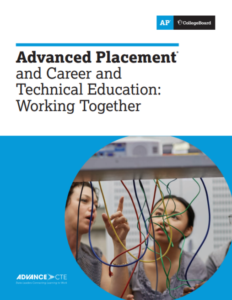 Advanced Placement® (AP) and Career Technical Education (CTE) courses can and should work in tandem to support career readiness by encouraging the development of the academic knowledge and technical skills that are, together, increasingly important to students’ overall employability. For too long, “college-ready” and “career-ready” coursework and experiences have been viewed as separate in schools. With an estimated
Advanced Placement® (AP) and Career Technical Education (CTE) courses can and should work in tandem to support career readiness by encouraging the development of the academic knowledge and technical skills that are, together, increasingly important to students’ overall employability. For too long, “college-ready” and “career-ready” coursework and experiences have been viewed as separate in schools. With an estimated